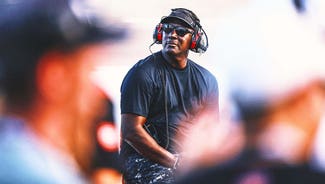
Busch crash leading to additional SAFER barriers at tracks
CHARLOTTE, N.C. (AP) International Speedway Corp. is developing a plan for the installation of additional SAFER barriers at Daytona and Talladega, and will review the safety standards at its other racetracks.
The renewed focus announced Tuesday by ISC President John Saunders comes three days after NASCAR star Kyle Busch broke his right leg and left foot in a crash into a concrete wall at Daytona International Speedway.
Busch left a Daytona Beach, Florida, hospital on Tuesday and was transferred to another facility in North Carolina for further treatment.
Busch was injured Saturday in the season-opening Xfinity Series race when his car hit an interior wall that did not have a Steel and Foam Energy Reduction barrier.
After his accident, Daytona president Joie Chitwood III vowed to cover every inch of the speedway with SAFER barriers.
Daytona is owned by ISC, the sister company of NASCAR.
Saunders said ISC is ''developing a significant plan'' for more impact-absorbing technologies that will not be limited to SAFER barriers for Daytona and Talladega.
ISC will also immediately review Phoenix International Raceway and Auto Club Speedway in Fontana, California, as both tracks host NASCAR races in March.
''We will utilize all available tools to ensure the safety of the drivers and our fans. It will remain our top priority,'' Saunders said in a statement. ''ISC is working very closely with NASCAR and industry experts to identify areas for additional safety protections.''
SAFER barriers were one of the many safety initiatives that came about after Dale Earnhardt's death in 2001 in an accident on the last lap of the Daytona 500.
The soft walls were developed by Dr. Dean Sicking at the University of Nebraska, and although they debuted in 2002 at Indianapolis Motor Speedway, they are currently installed in some form at every track used by NASCAR's top series.
The barriers, a combination of steel and foam, cost about $500 a foot. But, the cost has proven worth it as the walls absorb the energy during impact and have repeatedly lessened injuries sustained to a driver.
Still, they have not been placed everywhere around the racetracks. Tracks only install SAFER barriers where NASCAR recommends to them they should be placed. NASCAR, meanwhile, cites evaluations of high-impact areas in deciding where the material should be placed.
There have been numerous hard hits over the years in areas that were not protected with SAFER barrier, and it often has been rectified by the time the series returns. In 2013, Denny Hamlin hit an unprotected section of wall in Fontana, California, that caused a fractured vertebra.
NASCAR had Auto Club Speedway install SAFER barrier where Hamlin hit before the series returned last year. Las Vegas Motor Speedway did the same following a hard Jeff Gordon hit in 2008.
Reigning Sprint Cup champion Kevin Harvick hit the same wall Busch did in last year's Daytona 500, and was critical of the lack of SAFER barrier immediately following his own accident. He was pleased that Daytona was reacting after Busch's injury, but felt it was a bit late.
''The racetracks have to be proactive and they have to look ahead of an accident,'' Harvick said. ''We know what fixes these walls, and that's to put a wall in front of them.''
Even before ISC's announcement Tuesday that it would get additional SAFER barriers in at least two of its tracks, other facilities were being proactive in the wake of Busch's injury.
Atlanta Motor Speedway, host of this weekend's NASCAR races, reviewed its existing SAFER barriers on Monday and said it will enhance the existing barrier system before NASCAR arrives on Thursday.
The protective wall at the exit of Atlanta's pit road near Turn 1 will be extended, and a tire barrier will be added along the inside wall of Turn 4. The installations will add a total of 130 linear feet of additional protective barrier prior to this weekend's racing.
The track will consider future installation of additional SAFER barriers after Sunday's race.
Kentucky Speedway will add additional soft walls to the backstrech before NASCAR arrives in July.
New Hampshire Motor Speedway said it was already planning for additional SAFER barriers to be installed this year, but is now reviewing the plan to see if NASCAR will recommend even more soft walls.

